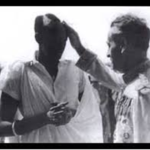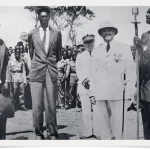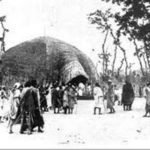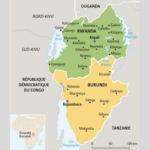The Political Complex In Comparisons Between The Central And Peripheral Areas of Ancient Rwanda
Up to this point We have been concerned with providing a basic outline of the ecology and population of Rwanda as a framework for the analysis of social control and conflict. It should be clear from the preceding chapters that pre-1900 Rwandan society constituted a bounded political and social system within clearly defined territorial boundaries which nevertheless contained within it considerable internal variations. The nature of these variations have been brought out in the comparisons between the central and peripheral areas of Rwanda.
We now come to the major concern of the matter, the analysis of social control and conflict situations in Rwanda which form a necessary part of the explanation of the situation of overt conflict which arase in 1961. an adequate explanation requires both diachronic and synchronic analysis. We have to analyse the traditional Rwandan social system, the impact of new factors on the system and the conflict situation which arase at the moment of independence from colonial rule. It is necessary to make a synchronic analysis of the Rwanda social system prior to the impact of major changes occurring from the early 1900’s. Here we have to analyse the latent elements of a conflict situation and the flexibility and forces of cohesion in the social system which contains these tensions. In this context it is important for the subsequent analysis to consider the latent conflict situation arising from the opposing centrifugal tendencies of the peripheral areas and the centripetal tendencies of central Rwanda. Developmental analysis is necessary to show how the forces of social cohesion were rendered inoperative over the time period from 1900 to 1961.A final synchronic analysis is necessary of te changed social system at the time of the eruption of conflict in 1961
This process of analysis which is necessary for an adequate interpretation of the problem of social control and conflict in Rwanda, relates to the wider controversy over the relationship of social anthropology and history.
The problems of analysis of the Rwandan material fit in general Smith’s concept that:“the appropriate field of study is a unit over time, not merely a unit at a particular point in time.” (Smith 1962 p.81)
He advocates that, as for our case in hand the field of study is a spatio-temporal unit or continuum, we may usefully begin with the hypothesis that this unit is, or forms part of, a system, many elements of which are somehow interelated. Moreover his hypothesis that the continuum under study represents a system neither includes nor excludes the possibility that it is part of a larger ystem or contains other systems. Since the system is a temporal unit it includes continuity and change alike and therefore requires combined synchronic and diachronic analysis.
In the case of Rwanda, prior to 1900 we are dealing with a largely self-contained system, which was subject to external influence only through its aggressive or defensive relations with other neighbouring societies. Prior to 1900, Rwandan society was a closed system in that there were institutionalised prohibitions on external contacts. This situation was given value and supported in myth. As a result of the introduction of colonial rule, Rwandan society became incorporated as a dependent sub-system in a different framework. This process of incorporation changed the’nature of the former relationships of the Rwandan system with outside forces. By becoming a sub-system, Rwandan society was no longer closed and self-contained.
In terms of developmental analysis, the fact of incorporation into a wider unit of colonial administration, introduced new factors which impinged on and changed the pre-existing balance of relationships determining the flexibility and forces of cohesion relating to social control and conflict. diachronic analysis of these changes both as they affected the total system and as they affected the inter-relationshipo between its various parts are imperative for the explanation of the conflict situation in 1961.
Moreover the Rwandan material demonstrates that a closer and more specific account of historical data may have to be taken than that which seems to be implied in Smith’s conceptual framework. Smith writes that:”Synchronic regularities isolate units and relations within static systems. Diachronic regularities reveal the outlines of an order within processes of simultaneous continuity and change. The objectives of diachronic analysis are to idntify this order, to determine its constancy, and to discover the logic which regulates it. The structure of a diachronic process consiste of these elements and their inter-relations.”(Smith 1962 p.82)
It is my contention that social anthropological analysis may sometimes profit by going one step further in the use of historical data. In the case of Rwanda we can see that a system is not only “a set of relations among events”, and thereby’neither completely continuous nor completely changing. Further than this it should be realised that a synchronic analysis of a system at a particular point in time may be influenced by the fact that not only is it subject to” diachronic regularities”, but also the form of the system itself may be influenced by particular historical events. This is of particular importance if, as in the case of Rwanda, the particular and possibly temporary form of the system at the introduction of colonial rule then becomes frozen and perpetuated in the process of being absorbed as a sub-system within a wider framework.
The form of the Rwandan social system which was found by the first German occupiers and which was subsequently adopted as the “traditional” Rwandan system by the Belgian administration and missionaries in the process of indirect rule, had been strongly influence by certain specific and verifiable historical events. The most important of these concerned the military campaigns of King Rwabugiri, a recent rinderpest epidemic and a serious famine. As Will be evident from a more detailed examination of these events, the form of the Rwandan system taken over under colonial rule was one in which the position of the king had reached a zenith point. Territorially this was a resultof his successful military campaigns, while within central Rwanda he had successfully eliminated powerful Tutsi lineages. His position was further favoured by the fortuitous occurrence of famine and rinderpest which created a situation of greater need and competition for the king’s favour. I shall now deal with these events in more detail and point out their implications for the current pattern of the Rwandan system in the early 1900’s.
King Rwabugiri, who reigned from 1853 to 1890, was the last king to tried to extend his influence through a series of military excursions. He failed to effectively incorporate regions which arenow in the Congo, but through military campaigns managed to enforce his control over large areas of North, North-East and South-west Rwanda. His campaigns against Urundi, the last of which was conducted in 1873, were a complete failure. Many Tutsi from those areas of Rwanda where he had managed to exert greater control went to Kivu Province of the Congo. However other areas remained completely outside any form of administration from central Rwanda.
“Jusqu’au début de notre siècle touts les territoires de Kisenyi, Ruhengeri, Biumba et Shangugu restèrent en pratique en dehors de l’administration central.” (Maquet and d’Hertefelt 1959 p.8).Moreover Kibungu, which had formerly submitted, revolted in 1900.
To enforce his position, Rwabugiri rearranged the districts, increased the number to twenty one and established a whole series of head-quarters all over the country. He broke up the power of important Tutsi lineages as much as possible and reduced the autonomy of local chiefs. His successor, Rutalindwa, lived only for one year when he and his family committed suicide to avoid falling into the hands of a rival to the throne. Rutalindwa was succeeded by Musinga who reigned until 1931.
The great rinderpest epidemic of 1890 to 1891 decimated large numbers of cattle. Several wars into neighbouring countries were organised “pour combler les vides”. These raids were called “mulyamo” or rinderpest razzia. On the one hand these wars contributed to the forces of social cohesion on account of the common aim which inspired them. On the other hand they demonstrate how those relationships which were based on the possession of cattle were upset,since the shortage of cattle created a situation of fiercer competition for the restoration of what had been lost. This gave the king greater power in manipulating relationships. This particular circumstance shows how external factors may have great influence on the internal operation of the system.
Another factor of great importance was the great famine of 1900. The early missionary reports testify to the enormously disrupting effect of this “act of God”. The famine was called “the great famine”. The missionaries reported on their arrival in 1901:
“There is hardly a family which has not lost at least one victim. Many have left and a large number of hills and houses have been abandoned.” The great famine was long remembered by the people who, as soon as another famine threatened, expressed the hope that it would not be as severe as the Ruyagu. From the missionary reports of 1917 to 1918, we can gather the extent of the casualties which were likely to have ensued from a serious famine.
Although my diachronie analysis is taken only from 1900, there is sufficient documentary evidence, to show that the Rwandan political system followed a cyclical process of aggressive expansion and peaceful consolidation. Military campaigns in warfare and raiding and also outbreaks of famine and disease were recurring phenomena in Rwanda. Although these events were regular occurrences, they brought about peculiar situations in the balance of relations between central Rwanda and the peripheral areas and also as regards internal social cohesion which is related to the power structure within the social system of Rwanda. In the traditional i.e. pre-colonial period, such temporary imbalances were subject to redress in the cyclical process. The point that I wish to make here is that when Rwanda became incorporated as a sub-system within the colonial framework, the peculiar pattern of events found in 1900 was no longer subject to redress through the operation of “traditional” processes, but was frozen and perpetuated through the support of exterior forces.
It is clear that the German and Belgian colonising powers and also the missionaries accepted this particular, albeit possibly temporary form of the Rwandan system as “traditional” and that which should be incorporated by them in the system of indirect rule. Von Gotzen the first military governor wrote in 1902:
“Our policy should aim at supporting the rulers’ authority” (Ryckman. 1953)
Hi s successor, Dr. Kant, repeated this position:”Our political and colonial interest require that we should support the king and maintain the Tutsi domination.”
In 1916 Belgian troups entered Rwanda and administered it as an occupied territory. In 1919 Belgium was given Urundi and Rwanda as a mandate territory. This was confirmed by a decision of the “Société des Nations” in 1923 and accepted by the Belgian Government on thirty first of August 1924.
When they took over from the Germans the same policy as expressed in the letters of Von Gotzen and Dr. Kant was followed as is clear from the following: Ordonnance legislative 6.7.1917
“Les sultans (i.e. les rois) exercent leurs attributions politiques et judiciaires dans la mesure et de la manière fixée par la coutume indigène.”
This intention to main-tain and continue the traditional system as it had existed at the particular period of 1900 is evidenced in further official documents up to as late as 1939. The following quotations illustrate this :Rapport sur l’administration belge au Rwanda – Burundi 1921 “l’autorité belge s’inspire de la ligne de conduite suivie anterieurement par l’autorité allemande: assurer la paix et l’ordre public en maintenant l’équilibre qui existait entre les groupements indigènes”. Rapport (idem). 1939 p.77.
“Qu’il doit s’efforcer de maintenir et de consolider le cadre traditionel de la classe dirigeante de Batutsi, à cause des grandes qualités de celle-ci, de son indéniabe superiorité intellectuelle et de son potential de commandement.”
This same attitude we find expressed in the missionary reports in 1919, Mgr. Classe, the Roman Catholic bishop of Rwanda remarks: “Nous n’aurons pas de meilleurs chefs, plus intelligents, plus capable de comprendre le progrès et mêmeplus acceptés du peuple crue les Batutsi.”
While in 1924 he wrote to the Governor of Rwanda: “If we wish to further the well-being of the country we must maintain the privilege of birth. The aristocracy of birth is a necessity at the moment.” (Lumen Vitae 1966 p.13)
The developmental analysis of the social system will have to take into account this historical evidence as to the attitude of the colonial powers.
This brings us back to the more specific implications of the fact that, under the influence of the colonising power, Rwanda became incorporated into a different and wider framework. This had a twofold effect. First of all the boundaries and external relationships of Rwanda remained fixed at the point which had been reached in 1900, having forces exterior to the system at its disposal, to ensure its stability. The importance of this will be more evident from the following survey.
In 1898 the peoples of the North and North-East revolted againet the King, and the German troops very forcefully supported the king’s troops in bringing them back under his authority. In the missionary report of 1905 we read:
“Les cris de mort contre les Européens retentissent partout” or in 1908: Pendant l’année trois fois les mausers allemands sont venus prêcher à nos voisins les avantages de la paix. Espérons-que ces leçons de choses ont été comprises.”
In 1901, Gisaka, which had been annexed after a bloody campaign in 1850, revolted, the German troops intervened and the Tutsi leader of the revolt, Rukura, was imprisoned in Usumbura, where he died. The years 1911 and 1912 saw a long and fierce rebellion in the North where both Tutsi, Hutu and Twa managed to hold out against several European conducted military campaigns. It is significant to note that the rebellion was led by a Tutsi challenger to the king, Ndungutse, who had the support of hutu and Twa. The Hutu were led by the local Tutsi chief Rukara, while the Twa were commanded by their own leader Basebeya. Ultimately Rukara and Basebeya were caught and executedby the Germans, while Ndungutse fled to Uganda where he was interned at Jinja and died there in 1918. In the South-west the districts of Busozo and Bukunzi managed to escape incorporation into the administrative structure operating from central Rwanda until 1926, when theBelgian authorities for the first time forcibly instated a Tutsi administrator. In 1913 a military campaign aiming to establish a Tutsi chief in Bashiru in the-North-East had to be abandoned. In the same year, the Governor, Kr. Kant, wrote to Mgr. Hirth, bishop of Rwanda:
“Les missions facilitent la tache du Governement. L’influence de vos missionaires nous a épargné la necessité d’y entreprendre des expeditions militaires. Le district du Bushiru est reste insonrcis jusqu’à ce jour. Je prie la Mission Catholique d’y établir un poste.”
From the above two points are clear. Firstly that as far as effective territorial contral of the administrative system of central Rwanda is concerned, very large areas of Rwanda were not only recently subjected through military campaigns, but also the situation was stabilised only as a result of the assistance of the colonial military force. Secondly, these revolts were not clashes between Hutu and Tutsi. On the contrary they were conflicts arising from the combined Hutu/Tutsi resistance of the peripheral areas against the efforts of central Rwanda to incorporate them into a unified administrative structure.
Although it is true that theNorth was largely Hutu, contrary to the pattern of central Rwanda, where hutu and Tutsi were residentially interspersed, in the North, North-East and South-west concentrations of Tutsi were found in the less fertile places and formed isolated pockets among the hutu population.
These Tutsi took part in or even led these rebellions. These examples could be multiplied but are enough to illustrate the importance of the particular historical circumstances. This has special reference to the peripheral areas where; « La normalisation administrative ne fût atteinte que sous l’époque coloniale européenne vers 1925- 1930. L’assimilation psychologique n’eut jamais lieu.” (Vansina 1962 p.81)
The administrative incorporation of peripheral areas was thus a direct result of Rwanda having become a sub-system in the wider framework of German and Belgian colonial policy. The second effect to be considered as a direct result of becoming a sub-system is related to the field of cosmological thaught which was given value in myth and expressed and upheld in several institutions. Since Rwanda came increasingly under the influence of western and Christian influence, these cosmological concepts and their associated institutions were undermined. Banyarwanda saw their society as the centre of the universe and« Le principe essentiel de la société Rwandaise était unifier tous les pays sous le roi unique de la dynastie de Banyiginya, on ne peut jamais avoir la paix définitive avec les pays voisins .»(Kagame 1952 P.54)
However this situation was brought to an end firstly by the demarcation of borders and secondly by the incorporation of Rwanda into one administrative unit together with Urundi, its enemy with which Rwanda had been perpetually at war. By coming under the authority of the colonial administration and thereby no longer having the possibility of taking part in aggressive and defensive politics, the system lost one of its elements making for internal social cohesion.
There is moreover the farther point that before European intervention Rwanda had so successfully cut itself off from external influences that there was practically no contact with people outside Rwanda. Since it was not only forbidden under pain of capital punishment to leave Rwanda without the special permission of the king, nor were foreign traders allowed to enter Rwanda. Banyarwanda were deprived of the possibility of making comparisons with other social systems. By becoming a sub-system, these boundaries and limitations were lifted and the social system as such beame exposed to the possibilities of external influences from which it had hitherto been isolated.
It is unnecessary to raise the question as to whether the peculiar combination of events described above can or cannot be seen as diachronic regularités of the system of political and social relationships in Rwanda. This is immaterial to the two points which I wish to stress. The first of these is that the peculiar form of the Rwandan system found in 1900 can only be fully explained as the result of certain specific historical events. Secondly, the possibilities of redress which were an inherent characteristic in the developmental cycle of the traditional system were removed when Rwanda became a sub-system in a wider framework. In this wider system the controlling authority eliminated these characteristics and stabilised the peculiar form of the system in 1900 as it had been influenced by particular historical events.
https://uk.amateka.net/the-political-complex-in-comparisons-between-the-central-and-peripheral-areas-of-ancient-rwanda/https://uk.amateka.net/wp-content/uploads/2019/10/file13-1-685x1024.jpeghttps://uk.amateka.net/wp-content/uploads/2019/10/file13-1-150x150.jpegSocial & cultureUp to this point We have been concerned with providing a basic outline of the ecology and population of Rwanda as a framework for the analysis of social control and conflict. It should be clear from the preceding chapters that pre-1900 Rwandan society constituted a bounded political and social...BarataBarata rpierre@ikaze.netAdministratorAMATEKA | HISTORY OF RWANDA




